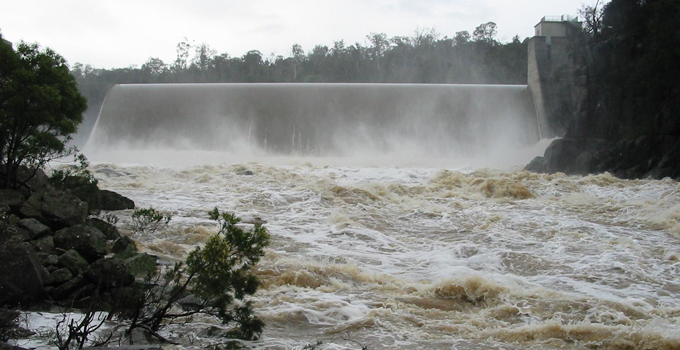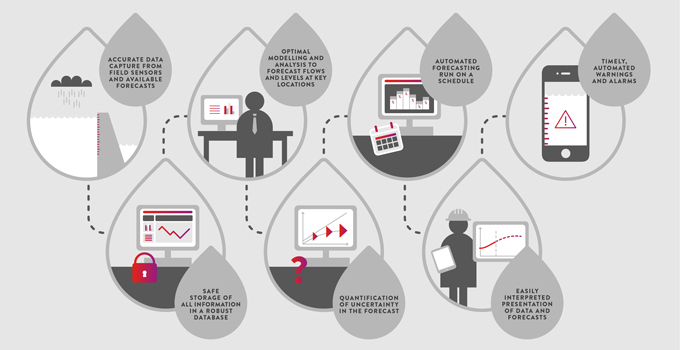THOUGHT LEADERSHIP
Key considerations for better flood forecasting
Flood forecasting is critical for protecting infrastructure and public safety.
In potentially catastrophic events, effective warnings save lives and avoid costly impacts on property, infrastructure, communities and the environment.
Effective flood forecasting systems provide accurate and timely warning of impending floods . Longer warning times provide greater opportunity to activate emergency management or evacuation plans and to manage water infrastructure.
Successful flood forecasting has obvious applications such as enabling informed operation of a dam to minimise flood peaks downstream, helping determine the need for emergency evacuation, managing river water quality within licensed limits, strategically operating hydropower stations to maximise power generation, or informing the timing or methods of major construction projects such as dams and bridges.
Flood forecasting systems
Flood forecasting systems simulate, display and communicate flood generation processes in a catchment. At the heart of a forecast system is the hydrologic model that converts real-time measured rainfall data and forecasts from weather forecasting agencies or numerical weather prediction (NWP) models into runoff and flow in rivers, or inflows to storages.
For some applications, the hydrologic models can be coupled with hydrodynamic models of the river and surrounding area to provide more accurate representations of flood levels and inundation areas. The forecasts can be displayed graphically on dashboards or mobile phone applications, and automated alerts and warnings can be sent to operators and water managers to manage flood risks.
Warning times and UNCERTAINTIES IN Flood FORECASTING
The chances of effectively managing flood risks improve with longer warning times . However, there is a trade-off between achieving longer forecast warning times and forecast accuracy.
Forecast accuracy depends on the availability and accuracy of the input data (rainfall data, forecasts, and flows) as well as the ability of the hydrologic and/or hydrodynamic model to accurately simulate flood producing mechanism in the catchment.
Flood forecasts based on real-time measured flow data are the most accurate, but they often cannot provide adequate warning times for effective management of flood risks.
Forecasts using observed rainfall data provide slightly longer warning times but also introduce uncertainties. This is because the hydrologic models used to convert rainfall to runoff are a simplified representation of the catchment. They cannot possibly represent all the intricate flood-producing processes that occur in nature.
Warning times are increased by up to a week or more using forecast rainfall data. However, rainfall forecasts are generated using numerical weather prediction models (NWPs) which simulate complex and chaotic processes occurring in the atmosphere and are prone to greater errors and uncertainties.
Despite greater uncertainty, longer term forecasts can indicate that a water manager should keep watch for the possibility of a flood, and can offer more time to ensure that the correct procedures are in place to manage a potential flood risk, and to take actions such as optimum storage management to capture floods.
Importantly, the uncertainty associated with the forecast at longer warning times should be recognised and estimated. Quantification and communication of uncertainty in forecasts provides additional confidence for making decisions about water management.
Seven attributes of superior flood forecasting systems
Investment in a flood forecasting system will provide the best access to the timely, accurate information a water manager needs in adverse conditions.
Entura’s flood forecasting approach involves effective data capture, storage, modelling and dissemination of information. Let’s take a closer look at the features of an optimal flood forecasting system:
|
Accurate data capture from field sensors and available forecasts
|
Data collection sites for flow, rainfall and water-level information must be properly maintained, and any problems with sensors quickly addressed. Automated quality checking is needed to detect major data errors or missing data. There should be redundancy in the network, and routines within the modelling should allow for infilling with data from other sites if one site is out of service. Ideally, a range of possible rainfall forecasts would be included in the modelling to indicate uncertainty in forecast rainfall amounts. |
| Safe storage of all information in a robust database | Storing all data used in forecasting, and the forecasts themselves, allows analysis of the suitability of the input data for forecasting, and analysis of the accuracy of forecasts. Comparison of forecast and actual data can be used to adjust the models. |
|
Optimal modelling and analysis to forecast flows and levels at key locations
|
Hydrologic and hydrodynamic modelling provide flows and water levels at critical points in the system, such as an inflow to a storage, the water level in a reservoir, the water level along a river, or an inundation area in a town. Models should be reviewed periodically with the most recent data to ensure that the parameters are still optimal and that the forecasts are performing as expected. |
| Quantification of uncertainty in the forecast | Ideally, forecasted inflows and levels should be accompanied by indications of the accuracy of the forecast. These are achieved by quantifying uncertainty in the forecast using statistical models and represented as high and low confidence intervals or assignment of probabilities to the forecasts. |
| Automated forecasting run on a schedule | The forecasting system should be fully automated, with the ability to run more frequently in a flood situation if required. Where practical, the system should be fully redundant. A stand-alone system operable with manual data inputs can provide back-up if all communications to a site are lost. |
| Easily interpreted presentation of data and forecasts | Operators and managers need to be able to easily interpret forecasting outputs to make decisions. The visualisation of the data should be tailored for the individual user and include an indication of certainty. Displays may include maps of forecast inundation areas, forecast river levels and flows, or rainfall over a catchment. |
| Timely, automated warnings and alarms | Automated alarms and warnings alert water managers of any forecast floods that may exceed critical thresholds, providing time to ensure appropriate preparation and action. |
In an increasingly volatile climate, with the likelihood of more extreme flood events, an effective flood forecasting system is a critical investment for water managers.
To discuss how Entura can partner with you to develop a best-practice flood forecasting system to help you better manage your flood-related risks, contact Phillip Ellerton on +61 439 010 172 or Shekhar Prince on +61 412 402 110.
MORE THOUGHT LEADERSHIP ARTICLES
30 November, 2017








